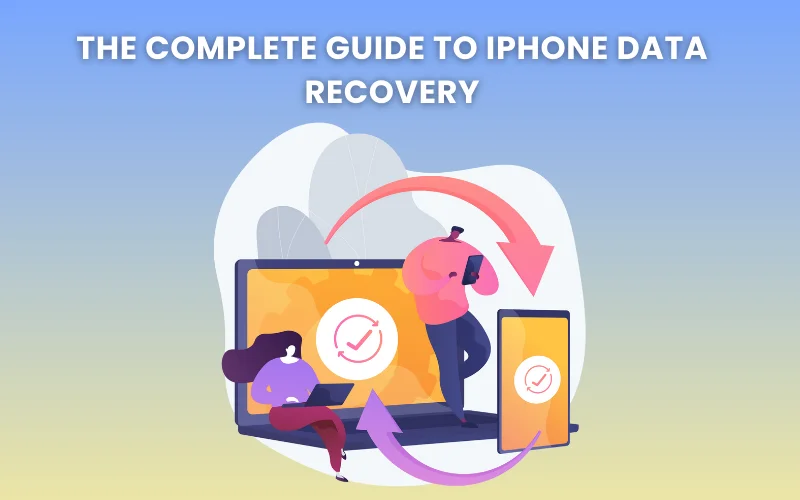Losing your iPhone data can be a painful experience. From photos to documents and contacts, losing any data that you store on your iPhone is stressful. Fortunately, most lost data can be recovered with the right steps at the right time.
But the main problem arises when you don’t know what you are supposed to do if you face this issue. But don’t worry! This comprehensive guide will walk you through everything you need to know when it comes to iPhone data recovery.
In this blog, we will look at the causes of data loss, essential DIY steps, and professional tools that can help in such difficult times.
Guide to iPhone Data Recovery
What is iPhone Data Recovery?
iPhone data recovery is the process of getting back your lost, deleted, or inaccessible files from your device’s internal storage or backup. This data can be photos, videos, contacts, messages, call history, and app data. Whether your data was accidentally deleted, corrupted, or lost due to a physical issue, with the right method, you can recover your lost data. You can recover your data using built-in Apple features or third-party software.
Common Causes For Data Loss
Data loss on an iPhone can happen for many reasons; it can be grouped into three main categories.
1. Human Error:
Human errors are the most common cause of iPhone data loss, which can include accidental deletion, failed or incorrect factory reset, which wipes all data from a device if a backup isn’t created, and forgetting passcodes also leads to data being automatically erased.
2. Software & System Errors:
Problems with your device’s OS can also lead to data loss. This usually happens when there’s a failed iOS update or a system crash. A corrupted file system or software glitches can render data inaccessible or cause the device to get stuck in a boot loop. In some cases, a device jailbreak gone wrong can lead to serious data corruption or total loss of data, as it bypasses Apple’s security protocols.
3. Physical damage
This is another common cause of data loss. Any physical damage can easily harm your iPhone’s functionality. One of the most common physical damages that causes data loss is water damage. This can short-circuit the internal components or parts of your device, leading to data loss. A severe drop can also cause significant damage to the internal parts of your iPhone, making it impossible to retrieve data without professional help.
Now that you know what can lead to data loss, let’s look at what your first course of action should be should you encounter any of these problems.
Your First Steps – DIY Recovery Methods
1. Check the “Recently Deleted” Folder: For Photos and videos, the first place to look is the recently deleted album within your Photos app. Items you have deleted are stored here for 30 days after deletion before being permanently removed.
2. Restore from iCloud Backup: If you have enabled your iCloud backup, then your data is likely saved in the cloud. To restore it, first, you must factory reset your iPhone. Follow the following steps –
Settings > General > Transfer or Reset iPhone > Erase All Content and Settings.
Once your iPhone reboots, keep following the instructions on your screen until you reach the “Apps & data” screen. Choose “Restore from iCloud Backup”. To restore from iCloud, simply sign in with your Apple ID and select the most recent backup.
3. Restore from a Computer Backup: Many people like to back up their iPhone on their Mac or PC, and if you are one of those, you can simply restore your data from there. Connect your iPhone to your PC, open Finder or iTunes, select your device, and choose “Restore Backup”.
These DIY methods require pre-existing backups. Suppose you didn’t create a backup, then these options aren’t going to work for you. This is exactly when you need external help, but wait! Before you think calling a professional is the only option you have left, you are forgetting about third-party data recovery software. These tools are designed to scan your iPhone’s internal memory and retrieve your lost data.
How to Choose The Right Data Recovery Tool
- Consider the Data Loss Scenario: To select the best tool for you, you need to consider the scenario in which you have lost your data. In case you have no backup, you need a tool that can directly scan your phone’s internal memory. If you have a corrupted backup, you need a tool that can extract data from it.
- Compatibility: Make sure the software you select is compatible with the phone you are using. Many software programs that are considered good may or may not support your device, depending on the model and iOS version.
- Features: Select a tool that allows you to preview your recoverable files, selectively choose what you want to restore, and support a wide range of file types. You can also look for more advanced features based on your individual needs.
- Reviews: Before finalizing, read reviews from reputable sites and other users. Check for post-buy reviews and comments about software success rate, ease of use, and customer support.
Preventing Future Data Loss: Best Practices
As the famous saying goes, “Prevention is better than cure”, you can always take preventive measures to make sure you don’t end up in a situation where you have to get recovery software or hire professional help. Let’s look at some preventive measures that can help you:
- Enable iCloud Backup: Go to Settings > Your Name > iCloud > iCloud Backup and turn it on. This will automatically back up your data daily when your phone is connected to Wi-Fi and power.
- Regular Local Backups: If you have a PC, then you should regularly back up your iPhone to your computer. This allows you to have an additional level of support in case your backup gets corrupted.
- Use Strong Passcodes: Enable a strong passcode, Face ID, or Touch ID to prevent unauthorized access.
- Be Cautious with Updates: Always back up your device before performing a major iOS update to avoid any sort of data corruption.
Conclusion:
Losing your iPhone data is a challenging experience. By taking your first steps using Apple’s built-in features for data recovery, you can often recover your lost data. If it fails, you can rely on a professional data recovery tool or a professional himself if the situation seems out of your control. Remember, by taking the right measures, you can always avoid such difficult spots.





